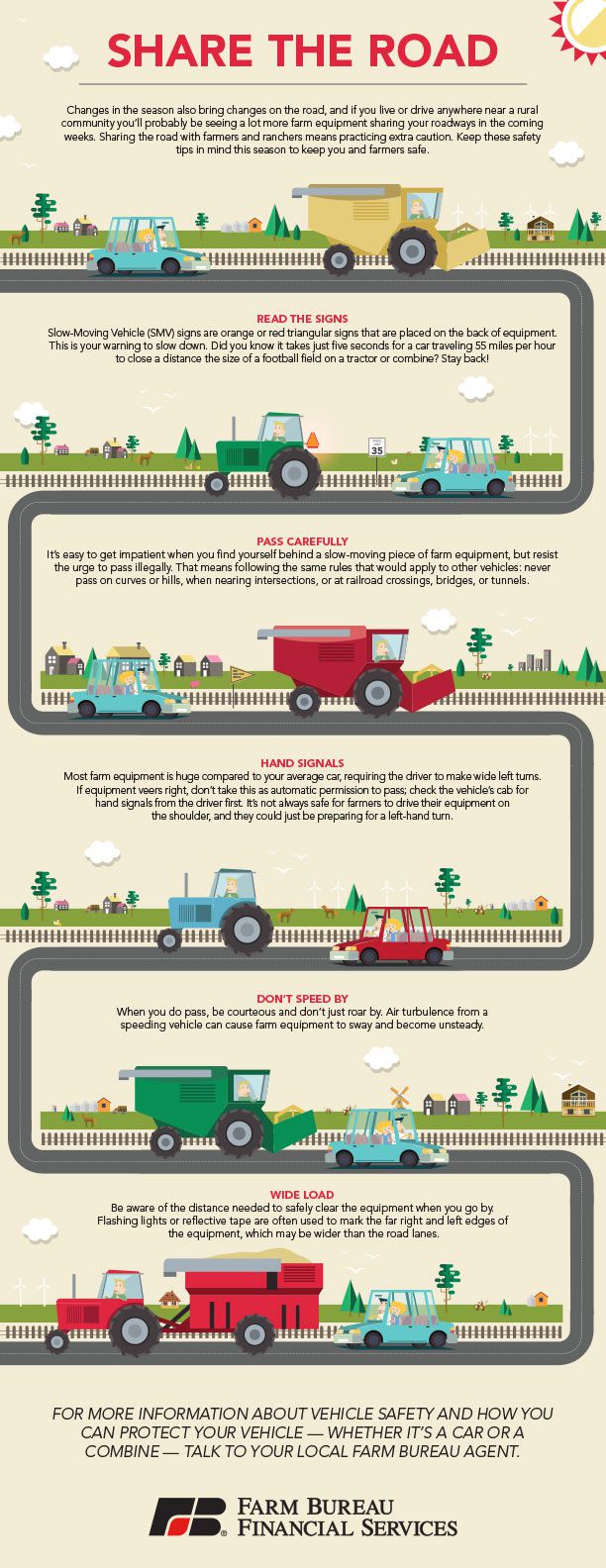Share the Road
Author
Published
3/5/2021
As farmers begin planting this spring, the likelihood of farm vehicle crashes increases. Farmers,
remember to mark your equipment with a Slow-Moving Vehicle emblem and outline your
vehicle with reflective marking on the widest points. It’s also a good idea to drive with your
equipment lights on, even in daytime. And motorists, remember to be patient with slower-moving farm machinery, and only pass when it is safe to do so. As we focus again on roadway safety as part of Ag Safety Awareness Week, we want to share this message from our financial partner Farm Bureau Financial Services below on ways we can all be safe on the road this season.

Changes in the season also bring changes on the road, and if you live or drive anywhere near a rural community, you’ll probably be seeing a lot more farm equipment sharing your roadways in the coming weeks. Sharing the road with farmers and ranchers means practicing extra caution. Keep these safety tips in mind this season to keep you and farmers safe.
For more information about vehicle safety and how you can protect your vehicle—whether it’s a car or a combine—contact your agent.

Changes in the season also bring changes on the road, and if you live or drive anywhere near a rural community, you’ll probably be seeing a lot more farm equipment sharing your roadways in the coming weeks. Sharing the road with farmers and ranchers means practicing extra caution. Keep these safety tips in mind this season to keep you and farmers safe.
Read the Signs
Slow-Moving Vehicle (SMV) signs are orange or red triangular signs that are placed on the back of equipment. This is your warning to slow down. Did you know it takes just five seconds for a car traveling 55 miles per hour to close a distance the size of a football field on a tractor or combine? Stay back and stay alert!Pass Carefully
It’s easy to get impatient when you find yourself behind a slow-moving piece of farm equipment but resist the urge to pass illegally. That means following the same rules that would apply to other vehicles: never pass on curves or hills, when nearing intersections, or at railroad crossings, bridges, or tunnels.Hand Signals
Most farm equipment is huge compared to your average car, requiring the driver to make wide left turns. If equipment veers right, don’t take this as automatic permission to pass; check the vehicle’s cab for hand signals from the driver first. It’s not always safe for farmers to drive their equipment on the shoulder, and they could just be preparing for a left-hand turn.Don’t Speed By
When you do pass, be courteous and don’t just roar by. Air turbulence from a speeding vehicle can cause farm equipment to sway and become unsteady.Wide Load
Be aware of the distance needed to safely clear the equipment when you go by. Flashing lights or reflective tape are often used to mark the far right and left edges of the equipment, which may be wider than the road lanes.For more information about vehicle safety and how you can protect your vehicle—whether it’s a car or a combine—contact your agent.
Want more news on this topic? Farm Bureau members may subscribe for a free email news service, featuring the farm and rural topics that interest them most!
